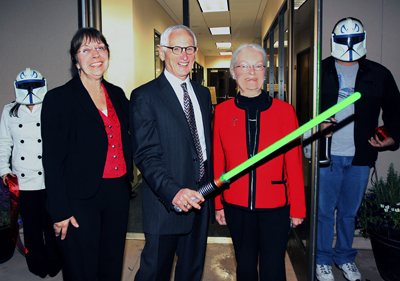Originally published Feb. 2013
By Lisa Y. Garibay
UTEP News Service
 A little less than two years after construction and relocation plans were announced, the Research and Academic Data Center (RADC, or “rad-see” as it is called by those in the know) has moved from its original location in the basement of Union Building West, where it had reached capacity, to the top of the sky bridge connecting the third floors of the Classroom and Engineering buildings.
A little less than two years after construction and relocation plans were announced, the Research and Academic Data Center (RADC, or “rad-see” as it is called by those in the know) has moved from its original location in the basement of Union Building West, where it had reached capacity, to the top of the sky bridge connecting the third floors of the Classroom and Engineering buildings.
On the afternoon of Feb. 19, more than 50 people gathered despite a surprise rainstorm, which resulted in a last-minute move of the grand opening celebration from the skybridge patio to a corridor inside the Engineering Building. The weather wasn’t enough to dampen the spirits of those who had invested much time and effort toward bringing high-performance computing to UTEP. Director of Research Computing Patricia Teller, Ph.D.; Vice President for Information Resources and Planning Steve Riter, Ph.D.; and UTEP President Diana Natalicio spoke about the tremendous return on investment that these computing capabilities would provide for the University, including faculty and student recruitment, research funding and enhanced recognition for UTEP.
The cutting-edge center houses the University’s high-performance equipment, used by research faculty members and students for high-capacity computing processes critical to their work. The additional space will allow for more research computing equipment, greater access and a wider variety of services that will in turn expand research opportunities. All the systems that are and will be housed in the RADC will be supported by a back-up disaster recovery data storage system.
The University spent more than $26.5 million on construction and other enhancements in and around the Engineering and Physical Sciences buildings complex, which includes the new Research and Academic Data Center. The RADC is now a secure home for research and academic servers and the Research Cloud @ UTEP. It is environmentally controlled and monitored around the clock with a UTEP access control system, professional system administration and management, 10GB connectivity to up to 14 high-performance cloud servers, and 10GB network capacity between select research units on campus.
“With each day, the role of computing grows in terms of how it’s interrelated to research. And with this growth comes the need for computing infrastructure, especially at institutions of higher learning,” said Teller, who was named the first director of research computing a year ago. Her appointment was key to the RADC’s relocation and growth. As the head of Research Computing @ UTEP, Teller is responsible for overseeing access to computing infrastructure and related education and training opportunities to facilitate research and accelerate discovery for UTEP faculty, students and staff.
“Through the support of the administration and the Office of Research and Planning, the Office of Research and Sponsored Projects, the College of Engineering, and the College of Science, we aim to make it more attractive for faculty to invest in this center rather than having clusters all over campus.”
She also pointed out that the capacity of the data center has doubled over the past year alone. Currently, 33 percent of the cloud’s infrastructure is associated with physics research and 15 percent is dedicated to bioinformatics research.
The RADC and research cloud have benefitted greatly from The University of Texas Research Cyberinfrastructure (UTRC) initiative, which cultivates high-performance computing, networking, data storage, education and training within the UT System. IBM pledged more than $90,000 in hardware and services towards the research cloud, contributing to the establishment of this first-ever cloud and virtualization computing environment for the University.
A short, entertaining video featuring animation and easy-to-understand translations of all the technology at work within this new environment played on a loop for grand opening attendees to watch and learn how virtualization enables researchers to employ multiple processing elements to solve a problem in less time.
IBM Client Representative Chuck Snapp was on hand for the grand opening and promised continued support throughout the center’s evolution.
“We are really honored and privileged to be a part of this whole event,” Snapp said. “There are really some incredible things ahead for your research community and your students.”